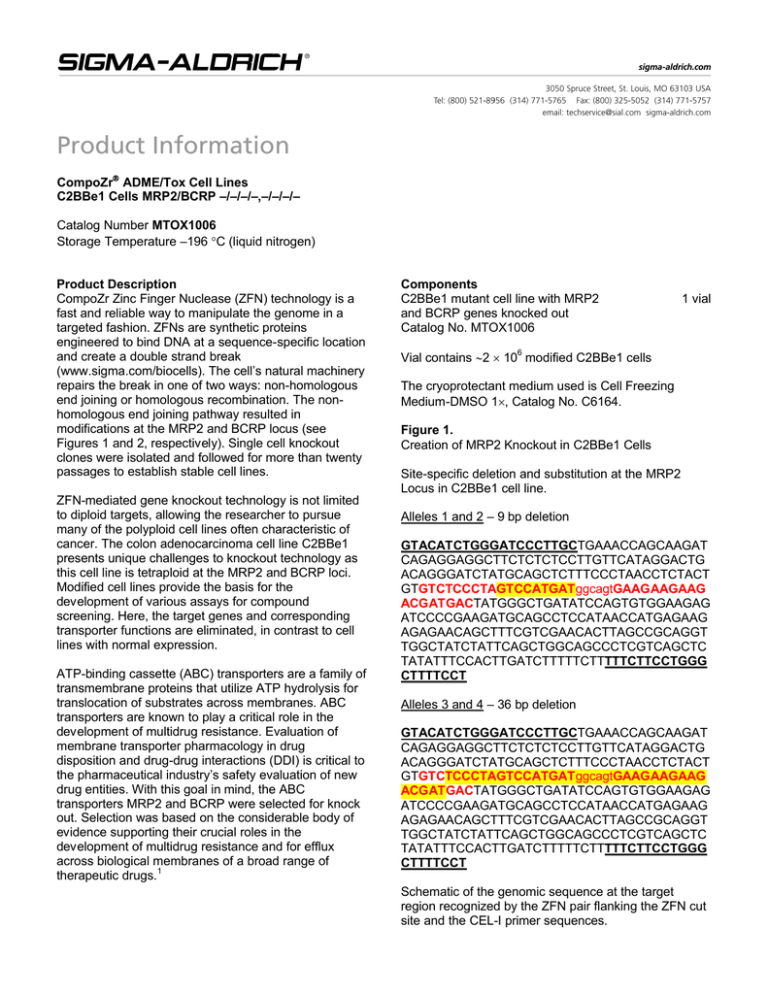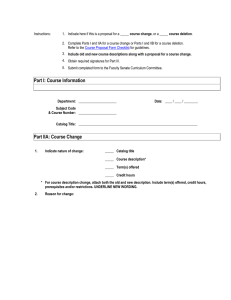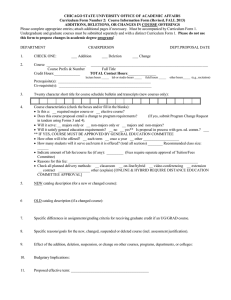
CompoZr ADME/Tox Cell Lines
C2BBe1 Cells MRP2/BCRP –/–/–/–,–/–/–/–
Catalog Number MTOX1006
Storage Temperature –196 °C (liquid nitrogen)
Product Description
CompoZr Zinc Finger Nuclease (ZFN) technology is a
fast and reliable way to manipulate the genome in a
targeted fashion. ZFNs are synthetic proteins
engineered to bind DNA at a sequence-specific location
and create a double strand break
(www.sigma.com/biocells). The cell’s natural machinery
repairs the break in one of two ways: non-homologous
end joining or homologous recombination. The nonhomologous end joining pathway resulted in
modifications at the MRP2 and BCRP locus (see
Figures 1 and 2, respectively). Single cell knockout
clones were isolated and followed for more than twenty
passages to establish stable cell lines.
ZFN-mediated gene knockout technology is not limited
to diploid targets, allowing the researcher to pursue
many of the polyploid cell lines often characteristic of
cancer. The colon adenocarcinoma cell line C2BBe1
presents unique challenges to knockout technology as
this cell line is tetraploid at the MRP2 and BCRP loci.
Modified cell lines provide the basis for the
development of various assays for compound
screening. Here, the target genes and corresponding
transporter functions are eliminated, in contrast to cell
lines with normal expression.
ATP-binding cassette (ABC) transporters are a family of
transmembrane proteins that utilize ATP hydrolysis for
translocation of substrates across membranes. ABC
transporters are known to play a critical role in the
development of multidrug resistance. Evaluation of
membrane transporter pharmacology in drug
disposition and drug-drug interactions (DDI) is critical to
the pharmaceutical industry’s safety evaluation of new
drug entities. With this goal in mind, the ABC
transporters MRP2 and BCRP were selected for knock
out. Selection was based on the considerable body of
evidence supporting their crucial roles in the
development of multidrug resistance and for efflux
across biological membranes of a broad range of
therapeutic drugs.1
Components
C2BBe1 mutant cell line with MRP2
and BCRP genes knocked out
Catalog No. MTOX1006
1 vial
Vial contains ∼2 × 106 modified C2BBe1 cells
The cryoprotectant medium used is Cell Freezing
Medium-DMSO 1×, Catalog No. C6164.
Figure 1.
Creation of MRP2 Knockout in C2BBe1 Cells
Site-specific deletion and substitution at the MRP2
Locus in C2BBe1 cell line.
Alleles 1 and 2 – 9 bp deletion
GTACATCTGGGATCCCTTGCTGAAACCAGCAAGAT
CAGAGGAGGCTTCTCTCTCCTTGTTCATAGGACTG
ACAGGGATCTATGCAGCTCTTTCCCTAACCTCTACT
GTGTCTCCCTAGTCCATGATggcagtGAAGAAGAAG
ACGATGACTATGGGCTGATATCCAGTGTGGAAGAG
ATCCCCGAAGATGCAGCCTCCATAACCATGAGAAG
AGAGAACAGCTTTCGTCGAACACTTAGCCGCAGGT
TGGCTATCTATTCAGCTGGCAGCCCTCGTCAGCTC
TATATTTCCACTTGATCTTTTTCTTTTTCTTCCTGGG
CTTTTCCT
Alleles 3 and 4 – 36 bp deletion
GTACATCTGGGATCCCTTGCTGAAACCAGCAAGAT
CAGAGGAGGCTTCTCTCTCCTTGTTCATAGGACTG
ACAGGGATCTATGCAGCTCTTTCCCTAACCTCTACT
GTGTCTCCCTAGTCCATGATggcagtGAAGAAGAAG
ACGATGACTATGGGCTGATATCCAGTGTGGAAGAG
ATCCCCGAAGATGCAGCCTCCATAACCATGAGAAG
AGAGAACAGCTTTCGTCGAACACTTAGCCGCAGGT
TGGCTATCTATTCAGCTGGCAGCCCTCGTCAGCTC
TATATTTCCACTTGATCTTTTTCTTTTTCTTCCTGGG
CTTTTCCT
Schematic of the genomic sequence at the target
region recognized by the ZFN pair flanking the ZFN cut
site and the CEL-I primer sequences.
2
CEL-I Primers – Bolded and underlined
ZFN binding site – UPPER CASE, BOLDED RED
ZFN cut site – lowercase red
Deletion – yellow highlighted
Genotype MRP2: deletion 9/deletion 9/deletion 36/
deletion 36
Figure 2.
Creation of BCRP Knockout in C2BBe1 Cells
Site-specific deletion at the BCRP Locus in C2BBe1
cell line.
Schematic of the genomic sequence at the target
region recognized by the ZFN pair flanking the ZFN cut
site and the CEL-I primer sequences.
CEL-I Primers – Bolded and underlined
ZFN binding site – UPPER CASE, BOLDED RED
ZFN cut site – lowercase red
Deletion – yellow highlighted
Insertion – green highlighted
Genotype BCRP: deletion 67/deletion 67/deletion 7/
deletion 5 and insertion 3
C2BBe1 clone: MRBC 4
Alleles 1 and 2 – 67 bp deletion
CACTGATTGCAAAGCCACAGAGATCATAGAGCCTT
CCAAGCAGGATAAGCCACTCATAGAAAAATTAGCG
GAGATTTATGTCAACTCCTCCTTCTACAAAGAGACA
AAAGCTGAATTACATCAACTTTCCGGGGGTGAGAA
GAAGAAGAAGATCACAGTCTTCAAGGAGATCAGCT
ACACCACCTCCTTCTGTcatcaACTCAGATGGGTTTC
CAAGCGTTCATTCAAAAACTTGCTGGGTAATCCCCA
GGCCTCTATAGCTCAGGTAACCAGCAGATTCTTTT
GAAATACTCAAATGGGAACAATGTGGTTCTGTTATC
ATCTGCTTCAGGATATGTTTATCTTCTACCCACCCT
TCCAA
Cell Line Description
Organism: Homo sapiens (human)
Tissue: colorectal adenocarcinoma
Age: 72 years
Gender: Male
Ethnicity: Caucasian
Morphology: Epithelial
Allele 3 – 7 bp deletion
Growth properties: Adherent
CACTGATTGCAAAGCCACAGAGATCATAGAGCCTT
CCAAGCAGGATAAGCCACTCATAGAAAAATTAGCG
GAGATTTATGTCAACTCCTCCTTCTACAAAGAGACA
AAAGCTGAATTACATCAACTTTCCGGGGGTGAGAA
GAAGAAGAAGATCACAGTCTTCAAGGAGATCAGCT
ACACCACCTCCTTCTGTcatcaACTCAGATGGGTTTC
CAAGCGTTCATTCAAAAACTTGCTGGGTAATCCCCA
GGCCTCTATAGCTCAGGTAACCAGCAGATTCTTTT
GAAATACTCAAATGGGAACAATGTGGTTCTGTTATC
ATCTGCTTCAGGATATGTTTATCTTCTACCCACCCT
TCCAA
DNA profile
Short Tandem Repeat (STR) analysis:
Amelogenin:X
CSF1PO:11
D13S317:11,13,14
D16S539:12,13
D5S818:12,13
D7S820:11,12
THO1:6
TPOX:9,11
vWA: 16, 18
Parental Cell Line: ATCC Catalog No. CRL-2102
Allele 4 – 5 bp deletion and 3 bp insertion
CACTGATTGCAAAGCCACAGAGATCATAGAGCCTT
CCAAGCAGGATAAGCCACTCATAGAAAAATTAGCG
GAGATTTATGTCAACTCCTCCTTCTACAAAGAGACA
AAAGCTGAATTACATCAACTTTCCGGGGGTGAGAA
GAAGAAGAAGATCACAGTCTTCAAGGAGATCAGCT
ACACCACCTCCTCCTCTGTcatcAaACTCAGATGGG
TTTCCAAGCGTTCATTCAAAAACTTGCTGGGTAATC
CCCAGGCCTCTATAGCTCAGGTAACCAGCAGATTC
TTTTGAAATACTCAAATGGGAACAATGTGGTTCTGT
TATCATCTGCTTCAGGATATGTTTATCTTCTACCCA
CCCTTCCAA
Note: Please see CRL-2102 product datasheet from
ATCC for additional information about the origin of
these cell lines. Cytogenetic information is based on
initial seed stock at Sigma Life Science. Cytogenetic
instability has been reported in the literature for some
cell lines.
3
Technical Note: When using C2BBe1 parental cells as
a comparator in functional efflux assays, it is crucial to
use parental cells with a passage number matching the
knock-out cell line being tested. Lot-specific passage
number is reported on the Certificate of Analysis of
each parental and knock-out cell line.
Precautions and Disclaimer
This product is for R&D use only, not for drug,
household, or other uses. Please consult the Material
Safety Data Sheet for information regarding hazards
and safe handling practices.
Biosafety Level: 1
This cell line is not known to harbor an agent known to
cause disease in healthy adult humans. Handle as a
potentially biohazardous material under at least
Biosafety Level 1 containment. The parental cell line,
C2BBe1, was obtained from ATCC. All animal products
used in the preparation of the knockout line and
maintenance of both, parental and knockout clone,
have been screened negative by 9CFR for adventitious
viral agents. Cell lines derived from primate lymphoid
tissue may fall under the regulations of 29 CFR
1910.1030 Bloodborne Pathogens. Appropriate safety
procedures are recommended to be used when
handling all cell lines, especially those derived from
human or other primate material. Detailed discussions
of laboratory safety procedures have been published.5-8
Storage/Stability
Upon receiving a shipment of frozen cells it is important
the end user gives the shipment attention without delay.
To ensure the highest level of viability, thaw the vial and
initiate the culture as soon as possible upon receipt. If
upon arrival, continued storage of the frozen culture is
necessary, it should be stored in liquid nitrogen vapor
phase and not at –70 °C. Storage at –70 °C will result
in loss of viability.
Precaution: It is recommended that protective gloves
and clothing always be used, and a full face mask
always be worn when handling frozen vials. It is
important to note that some vials leak when
submersed in liquid nitrogen and will slowly fill with
liquid nitrogen. Upon thawing, the conversion of the
liquid nitrogen back to the gas phase may result in the
rapid expansion of the vessel, potentially blowing off its
cap with dangerous force creating flying debris.
At the time a cell line is ordered, end users should also
consider the culture conditions for the new cell line and
make sure the appropriate medium will be available
when the cells arrive.
Preparation Instructions
Complete Medium
Dulbecco’s Modified Eagle’s Medium (DMEM)-high
glucose with 2mM L-glutamine and 10% (v/v)
(maintenance) or 20% (v/v) (initial thaw) Fetal Bovine
Serum. This medium is formulated for use with a 5%
CO2 in air atmosphere.
Medium Components:
DMEM, Catalog No. D5671
L-glutamine, Catalog No. G7513
Fetal Bovine Serum, Catalog No. F4135
Procedure
Information from the literature was used to establish a
procedure for culturing, freezing and thawing the
C2BBe1 cell line.6
Thawing of Frozen Cells
1. Thaw the vial by gentle agitation in a 37 °C water
bath. To reduce the possibility of contamination,
keep the O-ring and cap out of the water. Thawing
should be rapid (∼2 minutes).
2. Remove the vial from the water bath as soon as the
contents are thawed, and decontaminate by dipping
in or spraying with 70% ethanol. All of the
operations from this point on should be carried out
under strict aseptic conditions.
3. Transfer the vial contents to a centrifuge tube
containing 9.0 mL of Complete Medium [20% (v/v)
FBS] and spin at ∼125 × g for 5–7 minutes.
4. Resuspend cell pellet with the Complete Medium
[20% (v/v) FBS] and dispense into a 25 cm2 or a
75 cm2 culture flask. It is important to avoid
excessive alkalinity of the medium during recovery
of the cells. It is suggested, prior to the addition of
the vial contents, the culture vessel containing the
Complete Medium [20% (v/v) FBS] be placed into
the incubator for at least 15 minutes to allow the
medium to reach its normal pH (7.0–7.6) and
temperature (37 °C).
5. Incubate the culture at 37 °C in a suitable
incubator. A 5% CO2 in air atmosphere is
recommended for the Complete Medium.
4
Sub-culturing Procedure
2
Volumes used in this procedure are for a 75 cm flask;
proportionally reduce or increase volume of dissociation
medium for culture vessels of other sizes.
1. Remove and discard culture medium.
2. Briefly rinse the cell layer with EDTA solution,
Catalog No. E8008.
3. Add 2.0–3.0 mL of Trypsin-EDTA solution, Catalog
No. T4049, to flask and incubate at 37 °C for 10
minutes to detach the cells.
4. When cells are detached, add 6.0–8.0 mL of
Complete Medium [20% (v/v) FBS] and aspirate
cells by gentle pipetting.
5. Add appropriate aliquots of the cell suspension into
new culture vessels.
Sub-cultivation Ratio: 1:6 to 1:10 when 80-90%
confluent.
6. Incubate cultures at 37 °C.
7. After two passages, cells can be switched to
Complete Media containing 10% (v/v) FBS.
Note: To avoid clumping do not agitate the cells by
hitting or shaking the flask while waiting for the cells to
detach. Cells that are difficult to detach may be placed
at 37 °C to facilitate dispersal.
References
1. The International Transporter Consortium (2010
White Paper), Membrane transporters in drug
development. Nature Reviews Drug Discovery, 9,
215-236 (2010).
2. Fleming, D.O. et al., (1995) Laboratory Safety:
Principles and Practice. Second edition, ASM
press, Washington, DC.
3. Hay, R.J. et al., eds. (1992), ATCC Quality Control
nd
Methods for Cell Lines. 2 edition, Published by
ATCC.
4. Caputo, J.L., Biosafety procedures in cell culture. J.
Tissue Culture Methods, 11, 223-227 (1988).
5. Centers for Disease Control (1999), Biosafety in
Microbiological and Biomedical Laboratories
Human Health Service Publication No. (CDC) 938395. U.S. Dept. of Health and Human Services;
4th Edition U.S. Government Printing Office
Washington D.C. The entire text is available online
at www.cdc.gov/od/ohs/biosfty/bmbl4/bmbl4toc.htm
6. Chen, W., et al. in Cell Culture Models of Biological
Barriers In-Vitro Test Systems for Drug Absorptoin
and Delivery. (Lehr, C-M., ed.), Taylor & Francis,
(New York, NY: 2002) pp. 143-163.
§ Additional product and technical information can be
obtained from the catalog references and the Sigma
Life Science Website www.sigma.com/biocells
§ Please see the Label License Agreement (LLA) for
further details regarding the use of this product. The
LLA is available on our Web site at
http://www.sigmaaldrich.com/content/sigmaaldrich/areas-of-interest/life-science/zinc-fingernuclease-technology/zfn-license-agreement.html
§ These cells are distributed for research purposes
only. Sigma Life Science requires that individuals
contemplating commercial use of any cell line first
contact us to negotiate an agreement. Third party
distribution of this cell line is prohibited.
CompoZr is a registered trademark of Sigma-Aldrich Co. LLC.
ATCC is a registered trademark of American Type Culture Collection.
CRL-2102 is a trademark of American Type Culture Collection.
MB,ADM,PHC 08/12-1
2012 Sigma-Aldrich Co. LLC. All rights reserved. SIGMA-ALDRICH is a trademark of Sigma-Aldrich Co. LLC, registered in the US and other
countries. Sigma brand products are sold through Sigma-Aldrich, Inc. Purchaser must determine the suitability of the product(s) for their
particular use. Additional terms and conditions may apply. Please see product information on the Sigma-Aldrich website at
www.sigmaaldrich.com and/or on the reverse side of the invoice or packing slip.



